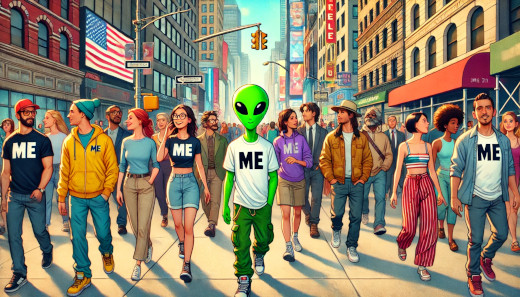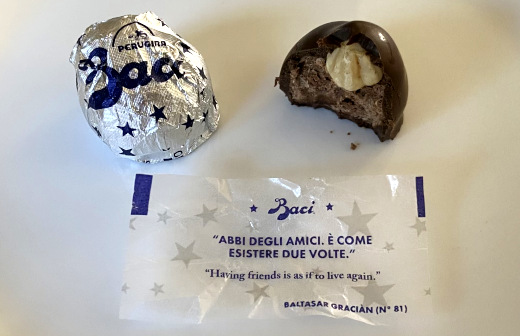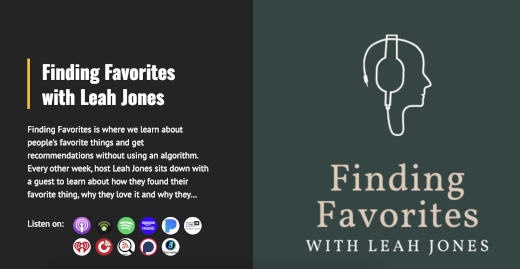Your Name As A Brand

AI-generated image of people walking down the street wearing clothing with ME on it generated by ChatGPT
One of my neighbors back in Chicago shared his last name with that of a popular apparel brand. On occasion I would see him and his family wearing that brand of clothing, and I always thought that was wicked cool. I never lamented there is not a clothing line with my last name, nor did I go to the extent of visiting one of the myriad of customizable clothing Web sites out there and order something with “MADDALONI” blazoned on it. Buying existing clothes with your name, that’s ok. Ordering your own clothes with your name, that’s a little much, even for me.
My surname is far from mainstream, but it is not entirely uncommon. The etymology of the name is not surprisingly Italy, and there are communities that bare my surname. Where I personally have never met other Maddalonis who are not a relative, I have connected with some online. I got a LinkedIn connection once from a college student who, as a youth, when he would Google himself my name would always come up, so he thought he’d connect with me. Yes, there are others named Mike Maddaloni out there, including him and the retired Secret Service agent whose book I read and shared my takeaways from years ago.
The name Maddaloni applied to people, surely. But attached to products?
Finding Myself
A holdover from the days of when I was actively managing my personal brand is Google Alerts for my last name. This free service from the Big Tech giant will send you a daily email of any mention of any string, phrase, name, etc. that appears new in the annals of Google’s databases and models. I’ve kept it running, for every once in a while, some Web site appears with a mention of me in it. These days those are rare, and most often the links include an Italian DJ/producer and a Long Island, New York based jewelry store. They have also informed me of long-lost relatives who have died.
The other week I got a Google Alert with a link to my last name on something I wasn’t expecting: a ductless island range hood in stainless steel.
The link in the Google Alert was to the above-shown listing on Home Depot Canada’s Web site. Upon further searching I found other links for this device for sale including on what appears to be the manufacturer’s Web site where other products are named after what also appear to be names that sound Italian.
I was tempted to contact the maker of this appliance, however after a past experience of a similar inquiry I decided not to.
If you think a range hood is random, how about a bikini bottom?
As the father of daughters, the last thing I ever want to be thinking about is bikinis. But there it was, a bikini bottom with the same name as said daughters.
The link was to the Web site of Silvia Tcherassi, a Columbian fashion designer. Captivated by this, I reached out to the email addresses listed on the Web site of her US-based headquarters to ask why my last name was tied to such an itsy bitsy teenie weenie product, however I never got a response. Where the item is no longer available on her Web site, you can see the (un)fortunately sold-out swimwear on Saks Fifth Avenue’s Off 5th Web site.
Deconstructing Your Name as a Brand Name
Many desire to see their name in lights, and others do not. Even when you do, seeing it in or on something can evoke emotions from amusing to embarrassing. Although I may not be buying my eponymous range hood, not am I not sadden by the unavailability of these bikini bottoms, it’s intriguing to know they are out there. Google Alerts and similar Web searches can alert you to what to look for, or what to simply avoid. Do you have Google Alerts for yourself, or have you searched on your name lately? I welcome you to share your thoughts – with or without your name – in the comments of this post.
This is from The Hot Iron, a journal on business and technology by Mike Maddaloni.
Did you enjoy this? Subscribe to The Hot Iron by RSS/XML feed or Read by Email
Build • Business • Strategize • (0) Comments • PermalinkMy Takeaways From Everything You Need To Ace American History In One Big Fat Notebook

As a proud history geek, I am naturally drawn to events, places and texts about the past. Perhaps it has something to do with growing up in Massachusetts and living in close proximity to many historical sites, some within feet of each other, such as what I wrote about these monuments in the eastern town of Arlington.
When I came upon the book Everything You Need To Ace American History In One Big Fat Notebook when perusing books at a thrift store, I was intrigued. Could such a book live up to its title? Would my own middle-schooler agree? Would I agree? As it was marked at the reasonable price of US$1.99, it was worth the “risk” to find out.
Before passing it along to my kid, I decided to read it first myself to see if it would pass my said standards. As you may have guessed I had some takeaways from it too.
High level, yet not a gloss over – I was impressed with the approach of the book. It covered a wide spectrum of US history, including both positive and negative aspects, such as slavery. The book started in the early 1600’s, including stories of Native Americans, and went through 2016 and the election of Barack Obama.
Shays’ Rebellion covered – Prior to cracking the orange cover of the book, I said to myself, “Self, I will be disappointed if there’s no mention of Shays’ Rebellion. Fortunately that never happened. If you are not familiar with what historians consider the first revolt within the newly formed United States of America – which took place within a few miles from where I grew up – it’s worth exploring.
I forgot a few details of American history, ok a lot of them – What can I say, there’s a lot of nuances to any history, let alone those of the Land of the Free and the Home of the Brave.
Written in a colorful style resembling a hand-printed and highlighted ruled notebook, Everything You Need To Ace American History In One Big Fat Notebook is complete with illustrations and maps. Although geared towards kids, it is a good resource for any adult to read and remind themselves of American historical events. It gets my seal of acceptance for a history book. Though I have passed it along to my kid to read, my timing couldn’t be any worse; she has a preference these days to the US History book she is using in her school class that she is getting graded on.
This is from The Hot Iron, a journal on business and technology by Mike Maddaloni.
Did you enjoy this? Subscribe to The Hot Iron by RSS/XML feed or Read by Email
Book Take-Aways • (0) Comments • PermalinkMike Maddaloni On Finding Favorites Podcast
I had the honor to be included in the Best of 2024 with Your Favorites episode of Finding Favorites, a podcast by Leah Jones.
What’s interesting about my appearance is that I had never heard Leah’s podcast before, namely as I didn’t know she did it! I saw her post on LinkedIn where she invited people to submit a recorded voice memo for this end of year compilation, something she has done for the past several years. Needless to say, I am a new subscriber to her podcast and am going back to listen to old episodes as well.
Finding Favorites is a show where Leah interviews people and asks them their favorite things, and then explores how they came about them. She includes in the description “without an algorithm” which I love, especially as much of what we think we are discovering online is likely fed to us via an algorithm of some form or another. The irony in this is that LinkedIn’s algo presented to me Leah’s post on submitting to this episode.
When she introduced me, Leah referred to me as, “one of the OG’s of Chicago Twitter,” and I smiled when she said that. Back in the late 2000’s when Twitter was becoming a social media platform of choice, I spent a lot of time on it. An awful lot of time on it. But it was time I considered well spent, as it expanded my social circles and I met many people I still keep in touch with today. It exposed me to much of what was going on in Chicago, both good and bad. Those early days were when people really wanted to connect with others, and I met many people through “Tweetups” – where people would connect online and decide to meet at a local bar or venue to get to know each other in person. Where I am no longer on Twitter for reasons I went into depth previously, I remember fondly those early days.
You can listen to the Best of 2024 episode of Finding Favorites here, and hear what my favorites were. You can also find the podcast on your favorite podcast app. Mine were a little more of a departure from what others posted, but those disconnected times and spending time with my family were truly highlights of my year.
This is from The Hot Iron, a journal on business and technology by Mike Maddaloni.
Did you enjoy this? Subscribe to The Hot Iron by RSS/XML feed or Read by Email
Announcements • (0) Comments • PermalinkItalian Treats at Christmastime

Christmastime is when I get to unplug from work by using up all the vacation time that I didn’t use throughout the year and spending time with family and friends, all the while celebrating the true meaning of the holiday. Add to it my Italian-American heritage, and it’s also a time to indulge in traditional treats I grew up with.
It likely comes as no surprise that food is an important part of any Italian-American celebrations. Even funerals. Especially funerals. Since I was a kid I could never figure out how, within a couple days of someone dying, the women of the family (and yes, it was usually only the women) were able to produce so much food. To top that, literal moments after they were dressed in black grieving at a funeral home, they are back at the house forcing food down my throat. But I digress, back to Christmas.
The Italian foods my family had around the holidays were on the sweeter side. Interestingly, my family never did the feast of the seven fishes that other Italians did. Why? Mainly because my Mom didn’t like half of the fishes, especially eel and baccala, the latter being salted cod. That was alright by me because and we made up for it on the other end of the taste spectrum. Here are a few of my favorite things for the end of the year. As I tell their tale, I will share how my family pronounced them with their Abruzzese dialect.
Pizzelles
If you’ve been a committed reader of The Hot Iron (and that term fits in so many ways), you know I have mentioned pizzelles (pronounced pit-ZELLS) before. Pizzelles are an Italian cookie made from simple ingredients; flour, sugar, eggs, butter and flavored and anise. There are other varieties of pizzelles, but for me anise flavored is the one only way to go. Although you can now buy them in some supermarkets, homemade using my Mom’s recipe is the tradition I am carrying on.
In recent years I have also adapted a grain-free, dairy-free version of Mom’s recipe, to which I am sure she would have approved. Using paleo/nut flour and maple syrup instead of sugar among other changes yield a quality cookie that allows me and the family to indulge in more (ok, maybe a little too much this year). This year I upped the game with a new pizzelle iron. Rather than using the non-stick one made in China I got on Amazon, I bought a pizzelle iron from an Italian-American founded company, made in Pennsylvania of cast aluminum, complete with my last initial engraved into the iron. This new addition to the family added an extra touch to the holidays.
Torrone

Torrone (pronounced tuh-RONE) is an Italian nougat and nut treat. As kids we would get the La Florentine torrone which came in small pieces wrapped in foil and in little boxes, with unique designs (and faces) for vanilla, orange and lemon. Of course you can’t just have one, and next thing you know the assortment box of 18 is all gone. That problem from my youth sadly still exists today, though the pieces are even smaller now. Torrone comes in other varieties, and this Christmas I tried a few other brands, however I went back to my old favorite (which my kids prefer as well). As some of the ingredients in torrone are on my quarantine list, I may explore making my own next year.
Baci

Baci (pronounced BAH-chee) are Italian candies made with dark chocolate and hazelnuts that recently turned 100. Baci is the Italian word for kiss, and each foil-wrapped treat contains a note – traditionally they were always about love, but these days they are famous quotes for some reason. Like torrone, Bacis are smaller and there’s fewer in a box, which for me is just fine as this treat that can be found at stores year-round is one I reserve for this time of year.
Panettone

Panettone (pronounced pan-e-TONE) is a sweet Italian bread that is made in a round loaf shape with dried fruits and wrapped in paper resembling a large cupcake liner. You slice the panettone (pie shaped or simple slices) and can eat it as is or toasted, the latter is what we always did. Again as most grains are something I deflect from these days I have found mini panettones at Trader Joe’s of all places, made in Italy and branded as Trader Giotto’s so I was still able to have a taste. I have even seen mini ones in Walgreen’s, however those are made in Brazil. By chance when buying local eggs at a Breadsmith artisan bakery I discovered they make panettones around the holidays, and theirs are made with a sourdough starter as well as slivered almonds. Despite my dietary preferences, this was a nice change to have a fresh-tasting panettone, as the store-bought ones have always been very, very dry.
Sfogliatelle

Sfogliatelle (pronounced sfo-ya-DELLS, plural) are toasted, flaky, Italian dessert filled with custard and candied fruit. Growing up we never ate cannolis and even when I had the opportunity to I would decline, much to the dismay of every non-Italian I know who assumes that’s all my people eat. Where I live in Wisconsin the closest Italian stores or bakeries are over 90 minutes away in Milwaukee, which is a good thing not to have these indulgences so close to home.
Growing up sfogliatelle were not exclusively a holiday treat, but by what could be called a Christmas miracle they are now. Several years ago we took a family vacation to Florida the week of Christmas, as we wanted to try a warmer climate for the holidays. As it so happened, we were at Universal Studios on Christmas Day. After getting through the mob at the front gate, I spotted a Today Show café (Universal is owned by Comcast that owns NBC) and a brief coffee break sounded good before taking on the park. As I placed our beverage order, in the display case in front of me was several varieties of pastries… and one sfogliatella! Needless to say, I ordered it and, believe what you want, but to me that was a certain sign my Mom, Aunts and Uncles were looking down on us and wishing us a Merry Christmas.
Deconstructing Christmas Treats
The holidays a conjure up a lot of meanings and thoughts at the end of the year, and a big one for me is nostalgia. I think back to growing up in an Italian-American household, complete with a lot of love and a lot of food, and the sweet treats at Christmastime were just as important as Santa and, of course, church. Even though the ingredients of these items are these days not among my favorite things, I am finding creative ways, coupled with moderation, to still carry on and pass along these cultural traditions, along with how my family pronounced them.
This is from The Hot Iron, a journal on business and technology by Mike Maddaloni.
Did you enjoy this? Subscribe to The Hot Iron by RSS/XML feed or Read by Email
Announcements • Thrive • (0) Comments • PermalinkThoughts On 18 Years of Blogging

As we change the proverbial calendar (because, who has a real one these days?), I wish all reading this (the several dozen of you) the 2025 you want.
For me, New Year’s Day is also a reminder that another year of blogging has come and gone. This one makes it “legal” at 18, which in some regards is hard for me to even comprehend. As I have stated before, what I went into with zero expectations has continued; though the volume of posts isn’t always as I would hope, the fact that people are still reading and occasionally contacting me by email or comments is always a positive sign.
Where I gave up on predicting the future years ago, I am taking a more concerted effort in defining my own, and I do hope to share tales of this journey as well as other stories from the past and present here on the digital pages of The Hot Iron. Perhaps I will read a book or 2 more this year and share my takeaways from them too.
Happy New Year!
This is from The Hot Iron, a journal on business and technology by Mike Maddaloni.
Did you enjoy this? Subscribe to The Hot Iron by RSS/XML feed or Read by Email
Announcements • Blogging • (0) Comments • Permalink



